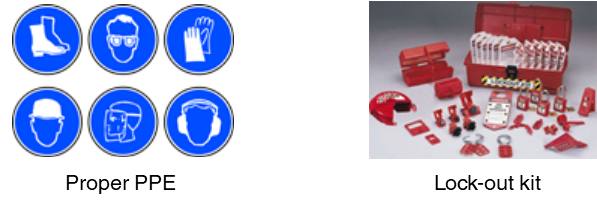
The importance of proper lock-out / tag-out
Injuries from ‘stored energies’ are some of the most critical and can include: burns, cuts, electrocution, entanglement, crushing, amputations, engulfment and asphyxiation. Although ‘electrical’ hazards are the most common, this also relates to other types of ‘stored energy’ such as: Hydraulic, Pneumatic, Pressure and Gravitational.
Workers who perform Lock-out/Tag-out must be competent and be able to show proof of receiving appropriate training
Prior to work, workers need to inform the ‘appropriate personnel’ that a Lock-out is required, as this may impact the business while the equipment is disconnected from its energy source
Workers should wear the appropriate Personal Protective Equipment as well as having the correct type of lock-outs, including locks and tags. (examples of lock-outs include: breaker lock-outs for electrical; blocks, wedges, pins and chains for hydraulic; piston, t-handle, lever and gate-valve locks for pneumatic
Prior to work, inspect the equipment to be locked out and establish your ‘safe-work zone’ using the POST Barricade Standard
Complete the appropriate safety paperwork; Safe-Work Permit / Job-Safety Analysis, as well as the Lock-out/Tag-out Critical Checklist and discuss with the operator or attendant

Locate the appropriate source of ‘energy’, and isolate (disconnect from ‘main’ power source)
Attach your ‘personal’ lock and tag to the lock-out. The key for the lock must remain with the worker at all times. The tag should contain the following information: your name, equipment effected, date of lock-out and expected date of completion

TEST by attempting to ‘power-on’ the equipment; this will ensure you have isolated the correct source of ‘energy’ (Testing is the most crucial step in a proper Lock-out Procedure; most injuries and deaths are a result of inadequate testing prior to performing work)
Once work is complete, inspect equipment and inform site personnel that ‘energy’ is about to be restored, (if multiple locks had been attached to the same lock-out, remove yours, keep equipment barricaded off and make plans to return once energy is restored)
If you are, a) leaving equipment locked out for an extended period, b) performing a transfer of lock ownership with a co-worker or c) performing a forceful lock removal – be sure to follow your companies’ specific procedure
Injuries from ‘stored energies’ are preventable;
COMMUNICATION and TESTING are key
to a safe Lock-out/Tag-out Procedure
Download a copy of this guideline
POST Best Practices – Lock out / Tag out
To print, select two-sided printing and fold
